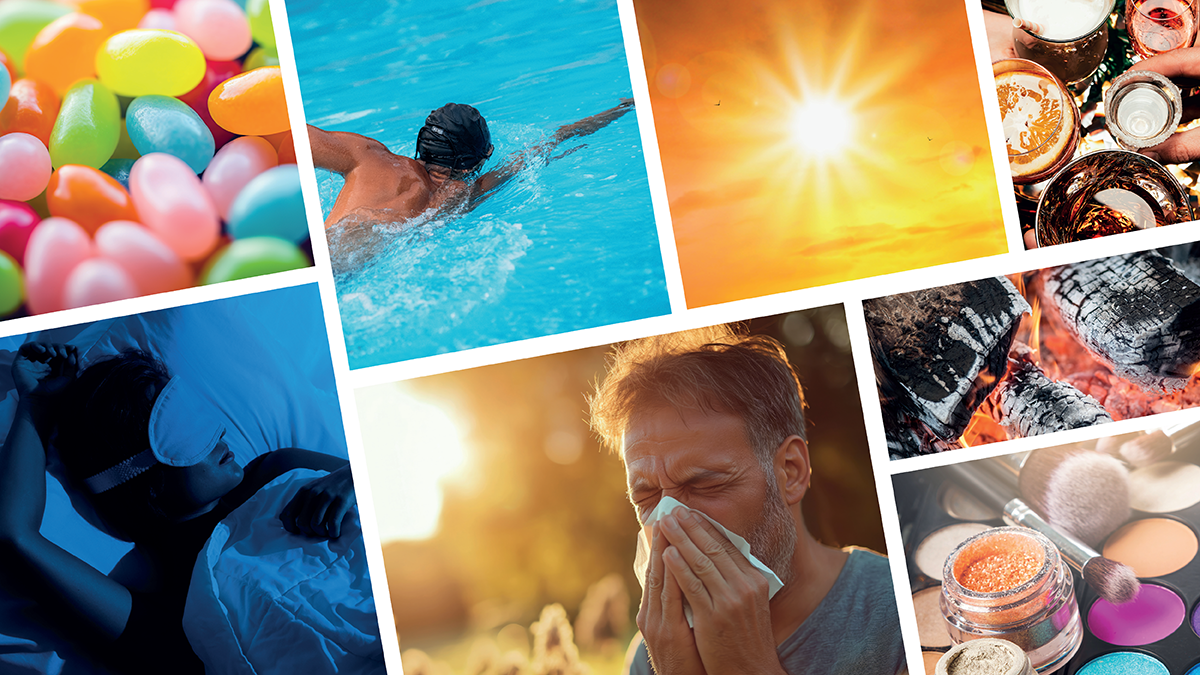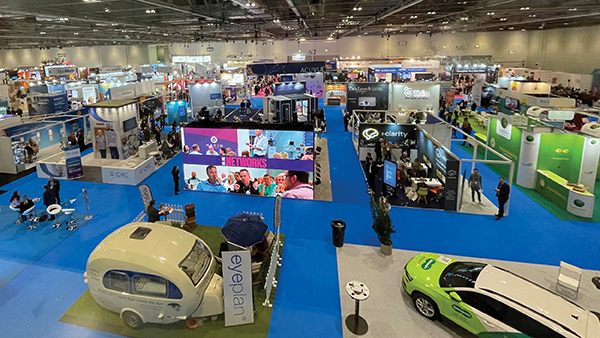The Eight “S’s” of Healthy Summer Eyes
What your patients should know to achieve a healthy, comfortable ocular surface while enjoying the warmer seasons
Sun, wind, and water can all be joyous elements of summer. They can also make it more difficult to maintain a healthy corneal surface. Our job: to educate patients on how they can protect their eye health without putting a damper on a fun, outdoor season. I like to tell my patients about the “Eight S’s”’ of summer, so they are prepared for the warmer months.
Sun
I recommend that patients wear a hat and sunglasses, and note that sunscreen should be a part of getting dressed every single day – even if it is overcast. The American Academy of Dermatologists recommends sunscreen that is water resistant, has an SPF of 30 or higher, and offers broad-spectrum (UVA and UVB) protection (1).
Patients are often hesitant to get sunscreen too close to their eyes because it can burn and sting for a long time if it gets in the eye. Nonetheless, it is vital to protect the eyelids. A study to estimate the prevalence of eyelid cancers in the American Academy of Ophthalmology Intelligent Research in Sight (IRIS) Registry found a prevalence of 0.14% (2).
Patients should use a product that dries quickly and stays put. I recommend Kinesys unscented SPF 50, which dries well and does not seem to migrate into the eyes. It can be applied slightly inside the orbital rim but should not come too close to the lash line.
For more complete eyelid coverage, I suggest sun sticks. They have a more adherent formula that helps keep them out of the eye when the user sweats or swims.
Swim
Both fresh and salt water can pose eye health challenges, and chlorinated pools can cause eye irritation. The ocean contains contaminants, as does fresh water, which also brings a risk of acanthamoeba and acanthamoeba keratitis. When possible, contact lens wearers swimming in fresh water should use prescription swim goggles instead of contact lenses.
I recommend instilling a good quality, preservative-free artificial tear following swimming to flush out any potential irritants and contaminants.
Shimmer
Many patients enjoy a glowing, sun-kissed look in summertime; however, it may be a good time to wear less makeup and let their skin breathe.
I have been studying the cosmetic component of happy, healthy, beautiful eyes for 20 years to best advise my patients on products that do not irritate the eyes or impact the meibomian glands. One of the most important elements of formulations for use in summer is that they do not run, smear, or leach into the tear film. We presented the paper, “Understanding Ocular Surface Irritation Potential from Mascara Products in the Dry Eye Disease Patient” at the ASCRS conference in 2022 (3). While conducting the study, I was shocked at how “clean” formulas smeared in interaction with an artificial tear. High-smear, nylon-fiber and rayon-fiber formulas are not friendly to the ocular surface.
Waterproof formulas are more effective at keeping materials out of the eye, but it is very important for patients to remove it nightly. We presented a poster at the ARVO 2017 annual meeting, “Cosmetic SPEED Scores,” showing that patients who did not remove their makeup nightly had higher Standard Patient Evaluation of Eye Dryness Questionnaire (SPEED) scores than patients who did remove makeup every single day.
For eye makeup removal, there are now two products on the market that have gone through the extra rigor of true ocular surface safety testing (the Lumify Eye Illuminations 3-in-1 Micellar Cleansing Water & Eye Makeup Remover from Bausch and Lomb, and Optase Life Sensitive Makeup Remover from Scope). Both products require the user to soak a cotton ball and give a little time to allow the waterproof products to solubilize and then be wiped away. I advise using a gentle makeup remover balm before applying these cleansers. Commercially prepared eyelid wipes can also be used to remove the last remaining traces of cosmetics.
In general, I advise patients to avoid using facial soaps and surfactants for their eyelid hygiene. I have often seen people use face wash on their eyelids to remove their makeup, but these solutions are much too harsh for the delicate eyelid area – creating dryness, stripping the meibum, and disrupting the skin epithelial barrier function.
Sweet
I urge my patients to avoid the processed sugars that often pop up at summer gatherings and instead choose natural, unprocessed foods that are nutrient-dense and high in antioxidants. I tell them the more antioxidants they eat, the better off their whole body is, including their tear film.
I also remind them to take daily omegas. I recommend HydroEye (ScienceBased Health) because it contains gamma-linolenic acid (GLA), which has been shown to help modulate the body’s inflammatory response, particularly in combination with EPA fatty acid, also provided in this formula (4, 5). Additionally, GLA directly stimulates the lacrimal gland, improving lacrimal output. Importantly, HydroEye was found to be effective in a double-blind, randomized, multi-center, controlled trial (6).
Sleep
It can be hard to sleep through the light and birdsong of an early summer dawn, but adequate, restorative sleep is important for good tear production. My patients report that their dry eye is worse when they do not get enough sleep, and research supports this perception (7). Good sleep hygiene is therefore especially important in the summer months.
Blackout blinds or a blackout mask help block light, and limiting screen use in the evening helps to protect your sleep (8). Patients should not have a ceiling fan blowing on them at night. Instead, I recommend sleeping with a fan pointing at the feet to keep cool without drying out the ocular surface. A silicon mask can also protect eyes from air flow while sleeping.
Smoke
During the massive Pacific Northwest forest fires in the summer of 2017, we recognized a connection between air quality and the MMP-9 inflammatory marker. Our analysis showed a very high correlation between MMP and air quality index (AQI), which we reported at the ASCRS annual conference in 2019 (9).
Sitting around a campfire is the local version of forest fire smoke exposure. Patients should be aware that poor air quality can lead to meibomian gland dysfunction and should rinse their tear film with a preservative-free artificial tear after taking part in this summer tradition.
Sauce
Alcohol is a part of summer fun for many people, but it is dehydrating. Additionally drying are the sun and wind often present at barbecues and other outdoor gatherings. If a patient is dehydrated, their lacrimal gland does not have adequate volume to produce the quality and quantity of tears necessary to keep up with the environmental demands.
Along with avoiding alcohol and staying adequately hydrated, patients can take other steps to help reduce the evaporative load during this warm, windy and social time of year, including lipid-based tear formulas, intense pulsed light, in-office thermal expression, and Miebo (perfluorohexyloctane ophthalmic solution) (Bausch + Lomb, Novaliq).
Sneeze
As grass and tree pollen increases, it is important that patients shower often and wash their eyelids well with commercial eyelid hygiene products to prevent allergens from dropping into the eye. If allergic conjunctivitis occurs or has been known to occur in a patient, it is important to address the situation; research has revealed an immunologic bridge between allergic conjunctivitis and meibomian gland dysfunction (10).
One strategy is to prevent the allergic cascade by using over-the-counter mast cell stabilizers and antihistamines, such as Pataday (Alcon) and Lastacaft (AbbVie). If there is a rhinitis component, over-the-counter fluticasone nasal sprays can be used.
If these measures are not enough, Alrex (loteprednol etabonate ophthalmic suspension) (Bausch + Lomb) is on label for allergic conjunctivitis; oral Singulair (Montelukast) can also be prescribed. Intense pulsed light can also be very helpful in getting allergic conjunctivitis under control. Avoidance of oral antihistamines is important as these products decrease tear production via lacrimal gland muscarinic receptor promiscuity.
If additional measures are necessary, an allergist can provide sublingual immunotherapy. There are also some exciting things on the horizon including thymic stromal lymphopoietin (TLSP) inhibitors.
Summer is a time to let loose and enjoy, and it is important to make it as easy as possible for patients to maintain their eye health at this time. A little knowledge helps them take small measures not only to make the season more pleasant, but also to maintain a robust corneal surface for the rest of the year.
References
Sunscreen FAQs. American Academy of Dermatologists Association. www.aad.org/media/stats-sunscreen. Accessed May 28, 2024.
Z Baş et al., “Prevalence of and Associated Factors for Eyelid Cancer in the American Academy of Ophthalmology Intelligent Research in Sight Registry,” Ophthalmol Sci., 3, 100227 (2022). doi:10.1016/j.xops.2022.100227
LM Periman, “Understanding ocular surface irritation potential from mascara products in the dry eye disease patient: a microscopic analysis of multiple products. Paper presented at: American Society of Cataract and Refractive Surgery (ASCRS) annual meeting, Washington, DC, April 22-26, 2022
R Kapoor, YS Huang, “Gamma linolenic acid: an antiinflammatory omega-6 fatty acid,” Curr Pharm Biotechnol., 7, 531 (2006). doi:10.2174/138920106779116874.
S Barabino et al., “Systemic linoleic and gamma-linolenic acid therapy in dry eye syndrome with an inflammatory component,” Cornea, 22, 97 (2003). doi:10.1097/00003226-200303000-00002.
JD Sheppard Jr. et al., “Long-term supplementation with n-6 and n-3 PUFAs improves moderate-to-severe keratoconjunctivitis sicca: a randomized double-blind clinical trial,” Cornea, 32, 1297 (2013). DOI:10.1097/ICO.0b013e318299549c
X Yu et al., “Dry eye and sleep quality: a large community-based study in Hangzhou,” Sleep, 42, zsz160 (2019). doi:10.1093/sleep/zsz160
B Hartley et al., “Do both timing and duration of screen use affect sleep patterns in adolescents?” PLoS One, 17, e0276226 (2022). doi:10.1371/journal.pone.0276226
L Periman, “Smoke Gets in Your Eyes: Air Quality Index Impacts on MMP-9 Testing during Forest Fire Season,” ASCRS 2019, San Diego, CA.
ascrs.org/clinical-education/abstracts/2019/smoke-gets-in-your-eyes-air-quality-index-impacts-on-mmp-9-testing-during-forest-fire-season. Accessed May 28, 2024.
NJ Reyes et al., “Induction and Characterization of the Allergic Eye Disease Mouse Model.” Methods in Molecular Biology, 1799, 49 (2018). doi.org/10.1007/978-1-4939-7896-0_5
The New Optometrist Newsletter
Permission Statement
By opting-in, you agree to receive email communications from The New Optometrist. You will stay up-to-date with optometry content, news, events and sponsors information.
You can view our privacy policy here
Most Popular
Sign up to The New Optometrist Updates
Permission Statement
By opting-in, you agree to receive email communications from The New Optometrist. You will stay up-to-date with optometry content, news, events and sponsors information.
You can view our privacy policy here
Sign up to The New Optometrist Updates
Permission Statement
By opting-in, you agree to receive email communications from The New Optometrist. You will stay up-to-date with optometry content, news, events and sponsors information.
You can view our privacy policy here







